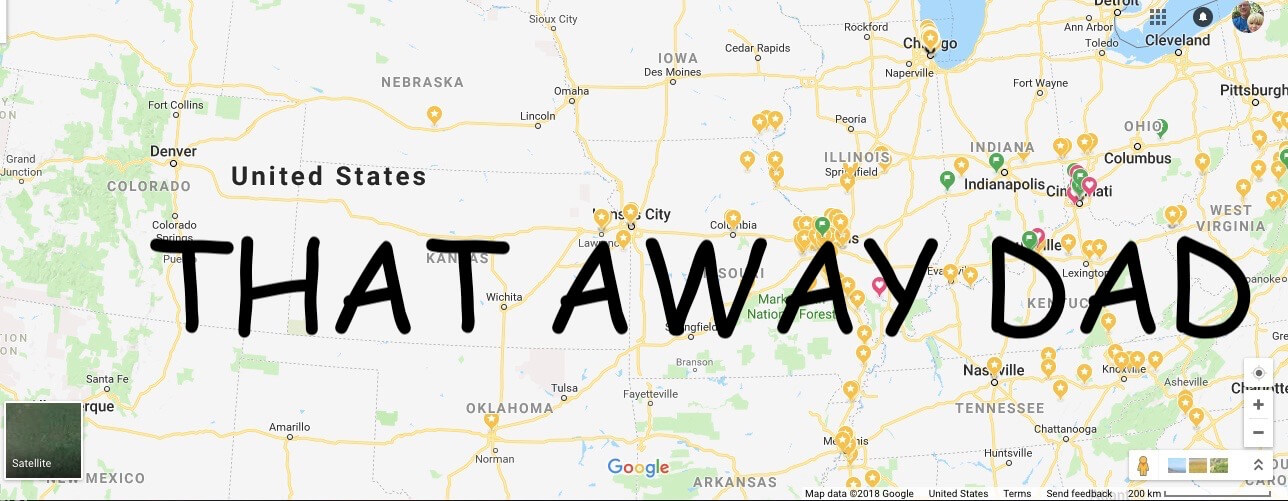See ancient Native American mounds on an easy-to-walk path at Dames Park in O’Fallon, Mo., just north of Interstate 70.
This is a 1.3-mile walk on a paved surface that follows the side of one-way streets and sidewalks in the park. The route is mostly level, with only 30 feet of elevation gain.

Start of the Hike
I parked in the first lot I encountered after entering the park. Then, I proceeded to the park road and walked on the side of the one-way street designated for pedestrians.

On the opposite side of the street stands the Omer J. Dames War Memorial, featuring flags and a monument. I continued along the road as it curved left around a concession stand and restrooms.

The trail continues to curve around a football field.

Next, I came to a road that turned left, leading to another section of the park. I took this road, which connects to the park’s southern area. It is two lanes, so be careful of traffic on this part. The route crosses a small stream.
After the crossing, I went to the left on the next section of Park Road.

The Mound
I noticed a large mound ahead and a sidewalk around it. I crossed a parking lot on the left to the sidewalk and used this around the mound with the road walkway on the right.

Information on the History of the Mounds
The first sign I came to said that 2,000 years ago, a large village extended north across nearby Missouri Highway P, and a large open-air market was located near Missouri Highway 79, where the O’Fallon sewage plant is located. Associated with these communities were earthen mounds.
Positioned in the cardinal directions are the informational signs. The sign explained how the mound faced. Directions were essential to life in the past — the east was the sun’s direction and represented sacred fire and life; the west was associated with the moon and the souls of the dead; the north was cold, and trouble and defeat, and the south represented warmth.
Extensive Culture
According to another sign, mounds extended across Missouri, but most have been destroyed and were part of an extensive trade network. In nearby Collinsville, Il., you can see Cahokia Mound, the largest Native American mound in the U.S. ( I did a previous hike at these mounds.)

A sign indicates that the streets of markets from 150 B.C. to 300 A.D. in this community were lined with ornate serving bowls, cooking vessels for your home, hunting gear or tools, and delicately carved religious items. A decorated bowl, pottery figurine, and platform pipe were recovered from the mounds in Illinois and are contemporary to the O’Fallon sites.

Early European cultures were initially credited with creating earthen works, while it was only after 1890, following extensive investigations by archaeologists, that Native Americans were recognized as the creators of these sites.

What Was Buried?
The last sign talks about how vital leaders were honored by burial mounds such as the one in Dames Park. Popular religious items found 2,000 years ago were small pottery objects named “Casper the Ghost” figurines for their T-shaped, marshmallow-like bodies, short arms, no legs, and heads with eyes represented by slits or lines. Archeologists speculate that Casper the Ghost figurines may have represented the spirits of ancestors or images of gods.

After the Mound
Next, I passed by a playground near a picnic pavilion and then returned to the road, going to the left.

There were more sports fields, and then, right before the bridge back to the first loop, there were pickleball courts.

Heading Back
Once across the bridge, I went to the right. Once again, I left the main road and went to the right to do a short loop by a playground near Peruque Creek.

A sign at the front of the play area discusses the early O’Fallon, Mo., Audrain settlement. James H. Audrain once owned an inn, distillery, and gristmill near the entrance to the park.
After leaving the playground, I followed the road to the right towards the parking lot where I had parked my car. On the left side of the road, closer to the parking lot, you can use a cement walkway to reach it.
Final Thoughts
The informational signs throughout the park allow visitors to learn the area’s history. If my son were with me, I would read them to him. The roadways and sidewalks are stroller friendly, although watch for one-way and two-way traffic at the bridge. If you only want to do the first look around, it is .4 miles. The second look is .6 miles around.

DETAILS:
Drive: Take Interstate 70 to exit 220, go north on Missouri Highway 79, and then make a left onto Main Street. Next, make a right onto Missouri Highway P and then a left onto Dames Park Drive. Parking is available throughout the one-way road throughout the park.
Hours: 6 a.m. – 11 p.m.
Address: 387 Dames Park Dr, O’Fallon, MO 63366

CAHOKIA MOUNDS HIKE
Explore Cahokia Mounds State Historic Site, an ancient six-square-mile city of 20,000 people and filled with huge man-made mounds.
MORE NATIVE AMERICAN SITES

Kress Farm Garden Preserve: Waterfalls and Native American Caves
Kress Farm Garden Preserve has wet weather waterfalls and cliff caves and is only 40 minutes outside of St. Louis.

Finding Petroglyphs at Washington State Park
Ancient Native American petroglyphs, a cave, and a historic stone overlook along Big River can all be enjoyed at Washington State Park about an hour south of St. Louis.

Piney Creek Ravine
The largest area of Native American Rock art in Illinois is found at Piney Creek Ravine Nature Preserve.
This 198-acre nature preserve also has cascading waterfalls and colorful limestone cliffs.


